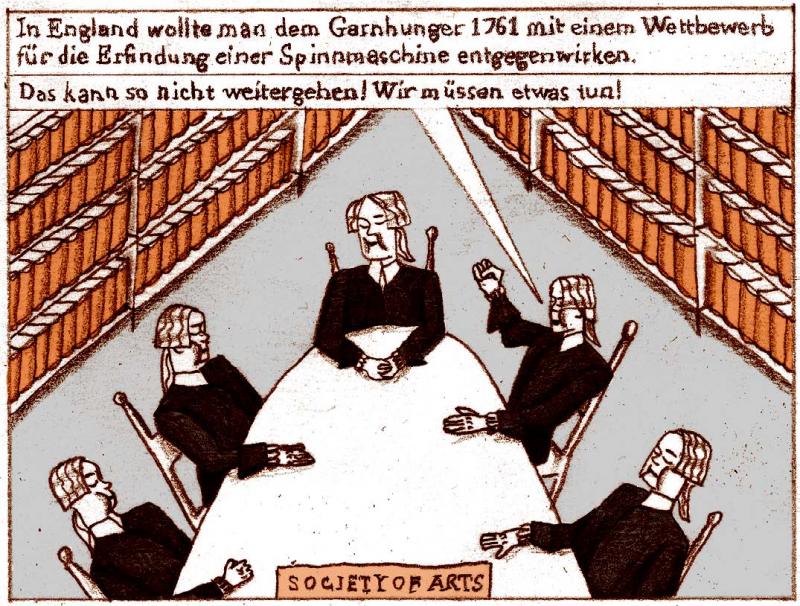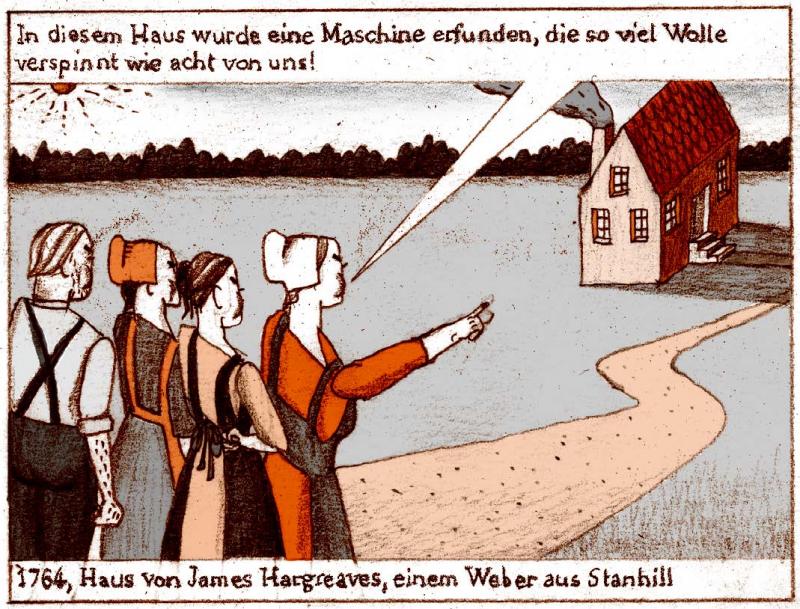The invention of the spinning jenny in 1764 sparked a movement that would change the lives of people worldwide. The economy had been stagnating for centuries. Eighty percent of the world’s population was working in the countryside; many were malnourished, with an average life expectancy of 28 years. However, the rapid mechanization of the textile industry spurred a period of growth, shifting the focus of economic and social life from the countryside to the expanding cities. This trend continues today: by 2050, 80 percent of the population will be living in cities, especially in southern Asia, Africa, and South America. These enormous changes require new solutions for supplying energy and developing infrastructure. Sustainable urban development would be a big step toward a sustainable Anthropocene future.

Spinning Jenny by James Hagreaves, Inv.-Nr.: 1910/25202
Milena Bassen
Spinning Jenny by James Hagreaves, Inv.-Nr.: 1910/25202
Milena Bassen
Drawn by Milena Bassen, 2014.  This work is licensed under a Creative Commons Attribution-NonCommercial-NoDerivatives 4.0 International License.
This work is licensed under a Creative Commons Attribution-NonCommercial-NoDerivatives 4.0 International License.
The spinning jenny
Text and images by Milena Bassen
University of the Arts (UdK), Berlin

Spinning Jenny: How a spinning machine gave impetus for capital- and industrial society.
“The weavers needs more yarn. I can’t keep up with spinning!”
Spinning Jenny: How a spinning machine gave impetus for capital- and industrial society.
“The weavers needs more yarn. I can’t keep up with spinning!”
Drawn by Milena Bassen, 2014.  This work is licensed under a Creative Commons Attribution-NonCommercial-NoDerivatives 4.0 International License.
This work is licensed under a Creative Commons Attribution-NonCommercial-NoDerivatives 4.0 International License.

“Here comes the next company for the spinning work…”
In order to compensate the industry’s demand for yarn, Germany ordered its soldiers to man the spinning wheels.
“Here comes the next company for the spinning work…”
In order to compensate the industry’s demand for yarn, Germany ordered its soldiers to man the spinning wheels.
Drawn by Milena Bassen , 2014.  This work is licensed under a Creative Commons Attribution-NonCommercial-NoDerivatives 4.0 International License.
This work is licensed under a Creative Commons Attribution-NonCommercial-NoDerivatives 4.0 International License.

In 1761 in England, a contest was held to invent a spinning machine.
“This cannot go on like this! We need to do something!”
In 1761 in England, a contest was held to invent a spinning machine.
“This cannot go on like this! We need to do something!”
Drawn by Milena Bassen , 2014.  This work is licensed under a Creative Commons Attribution-NonCommercial-NoDerivatives 4.0 International License.
This work is licensed under a Creative Commons Attribution-NonCommercial-NoDerivatives 4.0 International License.

“In this house, someone invented a machine which can spin eight times the amount wool than any of us!”
1764, house of James Hargreaves, a weaver from Stanhill
“In this house, someone invented a machine which can spin eight times the amount wool than any of us!”
1764, house of James Hargreaves, a weaver from Stanhill
Drawn by Milena Bassen , 2014.  This work is licensed under a Creative Commons Attribution-NonCommercial-NoDerivatives 4.0 International License.
This work is licensed under a Creative Commons Attribution-NonCommercial-NoDerivatives 4.0 International License.

“This machine won’t be replacing anyone anymore!”
“This machine won’t be replacing anyone anymore!”
Drawn by Milena Bassen , 2014.  This work is licensed under a Creative Commons Attribution-NonCommercial-NoDerivatives 4.0 International License.
This work is licensed under a Creative Commons Attribution-NonCommercial-NoDerivatives 4.0 International License.

But development could not be stopped. The machines got better and better, and soon one textile factory was built after another.
But development could not be stopped. The machines got better and better, and soon one textile factory was built after another.
Drawn by Milena Bassen , 2014.  This work is licensed under a Creative Commons Attribution-NonCommercial-NoDerivatives 4.0 International License.
This work is licensed under a Creative Commons Attribution-NonCommercial-NoDerivatives 4.0 International License.

The spinners had to move to their work into the cities. There they lived in inhumane conditions.
The spinners had to move to their work into the cities. There they lived in inhumane conditions.
Drawn by Milena Bassen , 2014.  This work is licensed under a Creative Commons Attribution-NonCommercial-NoDerivatives 4.0 International License.
This work is licensed under a Creative Commons Attribution-NonCommercial-NoDerivatives 4.0 International License.

“The factory owner is getting richer and richer, and I get poorer!”
The new machines produced goods in masses. Whereas before, many people could make only a little, nowadays one person could make a lot. But the wages stayed the same.
“The factory owner is getting richer and richer, and I get poorer!”
The new machines produced goods in masses. Whereas before, many people could make only a little, nowadays one person could make a lot. But the wages stayed the same.
Drawn by Milena Bassen , 2014.  This work is licensed under a Creative Commons Attribution-NonCommercial-NoDerivatives 4.0 International License.
This work is licensed under a Creative Commons Attribution-NonCommercial-NoDerivatives 4.0 International License.
Artist’s comment
As I researched on the spinning machine, it quickly became clear to me that one single invention can completely overturn a centuries-old craft and the way of life associated with it within a few years. In this case, an invention that gave rise to a new era: the industrialization. Textile workers are still having to cope with the consequences of this innovation today.
How to cite
Bassen, Milena. “The Spinning Jenny.” Environment & Society Portal, Multimedia Library, 2014. http://www.environmentandsociety.org/node/6659/.
The comic also appears in Alexandra Hamann, Reinhold Leinfelder, Helmuth Trischler, and Henning Wagenbreth, eds., Anthropozän – 30 Meilensteine auf dem Weg in ein neues Erdzeitalter. Eine Comic-Anthologie (Munich: Deutsches Museum, 2014).

This work is licensed under a Creative Commons Attribution-NonCommercial-NoDerivatives 4.0 International License.


